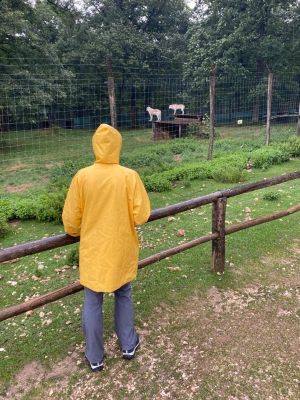The gaze
Luca Secker (Interns)
03.08.2021
 Big eyes. That is the first thing that strikes me at the WSC. While the wolves’ piercing, inquisitive gaze is fascinating, I am struck by the big eyes of visitors, when they make it up the hill and see the wolves for the first time. The little girl who pulls her grandma along on the arm, because she glimpsed at Taima scurrying by. And behold, grandma’s eyes are just as big, as both are captivated by the moment.
Big eyes. That is the first thing that strikes me at the WSC. While the wolves’ piercing, inquisitive gaze is fascinating, I am struck by the big eyes of visitors, when they make it up the hill and see the wolves for the first time. The little girl who pulls her grandma along on the arm, because she glimpsed at Taima scurrying by. And behold, grandma’s eyes are just as big, as both are captivated by the moment.
Especially when the wolves are active, for example, because they just received chicken dinner, you can see visitors lingering, simply watching, and trying to gain a deeper understanding about the living being in front of them. Similarly, my study colleague and I try to gain insight by observing those animals who seem so familiar, and yet so unbeknownst. Familiar, because they are right in front of us, still resembling man’s best friend (so much so in their summer coat that many visitors are puzzled whether they are looking at a dog or a wolf). And so unbeknownst, because in Europe not growing up with wolves, many of us only know them from eery fables.
That is why places like the WSC are so crucial, beyond the highly valuable scientific insights that astonish me, as often wolves and dogs are still remarkably similar, the WSC is a place of encounters. A place where people of varying levels of knowledge -from scientists, over regular guests, to people encountering wolves for the first time- can meet wolves eye-to-eye. I have not witnessed one person, who does not linger at least for a moment, when they see a wolf standing on their hut, gazing back at the visitors. These are short moments, when the eyes from both sides of the fence meet, leaving the visitors fascinated, moving
along just a bit more slowly. For me, these are symbolic moments. That is, because they give me hope that those people will face wolves returning to Europe at eye-level as well.